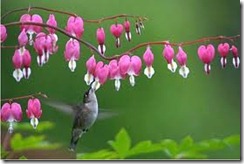Bleeding heart plants are a tad similar to roses in their dormancy patterns and need for carefully-timed consumption of water but they look different from one another. A bleeding heart plant has blossoms shaped like a heart with a protruding section in front that appears to be a drop of blood. The special care a bleeding heart plant needs is generally simple, however, even though it’s one rare plant that’s a bit hypersensitive to sunlight.
- Difficulty:
- Moderate
Instructions
things you’ll need:
- Compost
- Bark dust
- Pruning shears
- Watering equipment
- Shovel
Preparing for Growth
- Find a spot in a flower bed around your house that gets sunshine in the morning rather than during the day. Plant your bleeding heart plant in that location since these plants are sensitive to intense afternoon sunlight, much like roses. Withering can occur if bleeding heart plants get too much sun.
- Clear away any debris around the base of your newly-planted bleeding heart since that could inhibit growth. Spread about two cups of compost around the plant’s base. The compost spreading should be done annually around spring, right when the plant starts to bloom.
- Add approximately 2 inches of bark dust around the plant’s base for not only aesthetic purposes and to keep the soil moist, but also as a preventative measure to keep weeds from growing around the plant.
Watering the Plant
- Water your bleeding heart plant only when you start to see it bloom in the spring. If you planted it in the winter, don’t expect major growth until springtime. If you planted it in the spring or summer, you likely won’t see blossoms until the following spring when it’s fully grown.
- Schedule your watering of the plant to once every other week during spring months. Increase that to once every week during the summer when the sun is scorching. Only water for about an hour, however, since these plants could die getting too much water. Do just enough to keep the soil moist.
- Hydrate the plant only up to late summer. Don’t be alarmed if you see it dry up in late summer since bleeding heart plants start to go into dormancy by that time. It stays that way through the winter until blossoming again in the spring.
Other Care
- Clip down any dead growth down to no more than 2 inches during the winter months. This leaves room for the new growth in the coming spring. Wait until you see the first frost of the season before you do the clipping.
- Use a shovel and dig up your bleeding heart plant after five years and divide it up during dormancy periods. Doing this will encourage more growth in the same flower bed. This is easy to do without causing injury to the plant as long as you handle it delicately. Be sure to replant the roots down at least 3 or more inches into the soil.
- Watch your bleeding heart plant in spring and see if it blooms again. If it doesn’t, don’t automatically assume that it’s dead. Sometimes bleeding heart plants can lie dormant for longer due to a cooler spring. Wait until summer before making a final decision whether the plant is more than just dormant.
Tips & Warnings
-
Bleeding heart plants are almost always immune to plant diseases. However, always keep the soil clean around your plant, because dirty soil can make a bleeding heart develop stem rot.


Deprecated: strpos(): Passing null to parameter #1 ($haystack) of type string is deprecated in /home/agriviek8Qv/agriviet.net/public_html/wp-includes/comment-template.php on line 2522